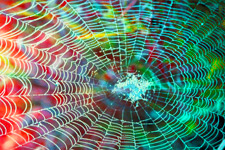Commentary
Knowledge Graph, Satori, and Unicorn
- by Laurie Sullivan , Staff Writer @lauriesullivan, March 21, 2013
 Tying together multiple profiles and networks to serve up information about a person, a place or a thing creates challenges for search engines. It's like stringing or graphing together
an underlying net below the surface of the Web to connect all things throughout the world. It is based on the relationship between entities or links.
Tying together multiple profiles and networks to serve up information about a person, a place or a thing creates challenges for search engines. It's like stringing or graphing together
an underlying net below the surface of the Web to connect all things throughout the world. It is based on the relationship between entities or links.
Google created the Knowledge Graph, which will become the backbone for artificial intelligence built into products and services, spearheaded by Ray Kurzweil, futurist and AI expert. Now Microsoft Bing will give it a try.
The technology becomes the system that is smart enough to connect the dots and search on the someone's behalf -- creating a push model rather than pull that is helping people do things rather than find them.
Last June, Bing introduced Snapshot, which enables people to get answers at a glance in the center column of the search results page. The feature started with movies, restaurants and hotels. The underlying technology, Satori -- which means understanding in Japanese -- will connect "billions of entities and relationships" in time to serve up more useful information about the physical world. It taught Bing how to understand the Web.
The Satori graph-based repository, derived from Trinity, Microsoft's graph database, now encompasses many more connected entities from a variety of domains with a deeper level of understanding about them, according to Richard Qian, from the Bing index team. The concept gives six degrees of separation a new twist.
Facebook also uses the same process in Search Graph -- but turned metadata for nodes into social interactions, so it can tell you things like close-by entities or things people liked or shared. "The heart of Graph Search is called Unicorn, an in-memory database based on an inverted index.
Inverted indexes have been used by a number of search technologies that associate words, fragments of words, or types of relationships with attributes of entities within Facebook's graph database. Those associations, called 'marks' by Facebook, are stored in a Unicorn in-memory index, pointing to the Facebook numerical identifier for related entities," according to ArsTechnica.



